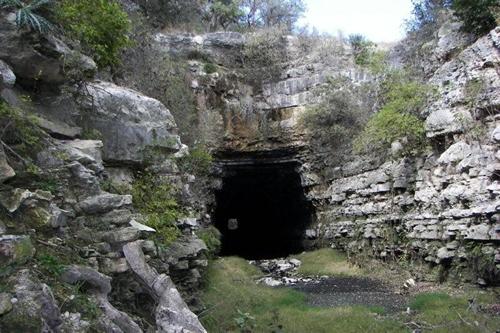|
Railroad in
the Red,
and Brazilian Bats
OLD
TUNNEL STATE PARK
by Mike
Cox |
|
| "Since
1991, the old tunnel and 16.1 acres around it have been owned by the
Texas Parks and Wildlife Department, which now operates it as a state
park – Texas’ smallest. Some three million Brazilian free-tailed bats
live in the abandoned tunnel from May through October each year, along
with a much smaller population of Cave myotis bats." |
The
first thing anyone notices while walking down the trail toward the
old tunnel is the smell, the olfactory result of all the guano deposited
by the 3 million or so bats that live there part of the year.
Fortunately for visitors, the odor lingers only in a short segment
of the half-mile trail that goes past the long-abandoned railroad
tunnel and loops around what remains of the railbed that led to it.
While the stench of bat droppings is transitory, what endures at Old
Tunnel State Park 10 miles southeast of Fredericksburg
are a couple of lessons symbolized by the 920-foot tunnel beneath
a Gillespie County
prominence called Alamo Ridge. |
 |
The first lesson
is a good example of the old saw that it’s best to be careful what
you wish for.
Founded
in 1846 when ox-drawn wagons represented the state of the art in transporting
freight, Fredericksburg
was the last stopping place for Western-bound travelers for decades.
However, by the mid-1880s Texas’ frontier
had mostly faded and Fredericksburg,
while still a good place to spend the night, had settled into a comfortable
status as county seat and local trade center.
Many Texas towns owed their existence
to railroads, but
Fredericksburg
remained accessible by road only. Then, in 1887, the San Antonio and
Aranasas Pass Railway connected nearby Kerrville
(only 22 miles from Fredericksburg)
with the Alamo City
and points beyond.
For the next quarter century, the powers that were in Gillespie
Count tried to get rail service for their county seat. More than
two dozen attempts to develop funding for a railroad connection to
Fredericksburg
failed for various reasons, but one man who kept at it was Temple
Smith, a Virginian who had opened a bank in the then-predominantly
German-American town.
In 1913, teaming with engineer Foster Crane, who had been involved
in the development of Medina Dam near San
Antonio, the two men finally came up with the money to build the
railroad, which would extend 24 miles from Fredericksburg
to the existing trackage of the San Antonio and Aransas Pass (known
as the SAP) between Waring
and Comfort.
But because of a 300-foot increase in elevation from that point to
Fredericksburg,
and the rugged hills that had to be traversed, it proved far more
expensive to build the line than had been anticipated. The new route
required either a trestle or a bridge for about each mile of its length,
and at the highest point — Alamo Ridge — the tracks would
have to extend through a tunnel.
Workers used dynamite stuffed into holes drilled into the limestone
with hand tools to blast out the tunnel. A team on each side of the
hill worked to meet in the middle, digging in three levels so they
wouldn’t have to use scaffolding, which would have raised construction
costs even higher. For probably the same reason, the tunnel never
had internal supports. The tunnel cost $134,000 to dig back when that
was a huge amount of money. In fact, that aspect of the project caused
a 67 percent cost overrun, an economic burden the line never overcame.
The
first train arrived in Fredericksburg
in October 1913, but the official celebration of new rail service
did not come until Nov. 18, when the railroad’s lone engine pulled
a passenger car full of VIPs from San
Antonio into the town’s new depot. Portending future trouble,
the train rolled in three hours late.
Never known for its on-time record, the new railroad line experienced
delays because of chronic maintenance issues along its trackage. In
addition to that, trains had to stop before going into the tunnel
so that crew members could check for any large rocks that might have
fallen on the track. Smaller rocks often pelted the roof of the train
as it passed through the tunnel.
Crippled by inordinately high debt and lower-than-expected demand
for freight or passenger service, the railroad enjoyed only a brief
period of prosperity during the late 1920s oil boom. But that ended
with the stock market crash, and the road never again got out of the
red.
Finally, in 1942, it went out of business. The last train pulled out
of Fredericksburg
on July 29 and within a week, crews had begun ripping up the tracks.
With another world war under way, the War Production Board purchased
the rails for use in building a road to Alaska. Some of the tracks
also were shipped to Australia.
The
second lesson offered by the old tunnel illustrates the law of unintended
consequences. With trains no longer passing through the tunnel daily,
it became excellent bat habitat. Since 1991, the old
tunnel and 16.1 acres around it have been owned by the Texas Parks
and Wildlife Department, which now operates it as a state park.
Some three million Brazilian free-tailed bats live in the abandoned
tunnel from May through October each year, along with a much smaller
population of Cave myotis bats. As a popular tourist destination,
the old tunnel brings more revenue to Fredericksburg
than the railroad line ever did.
© Mike Cox
- November 28, 2012 column
More "Texas Tales" |
|
|

 Gulf
Coast
Gulf
Coast East
Texas
East
Texas Central
North
Central
North Central
South
Central
South Panhandle
Panhandle South
Texas
South
Texas Hill
Country
Hill
Country West
Texas
West
Texas Ghost
Towns
Ghost
Towns COUNTIES
COUNTIES